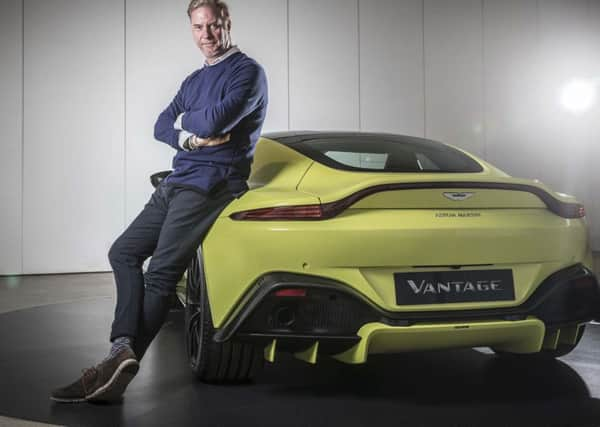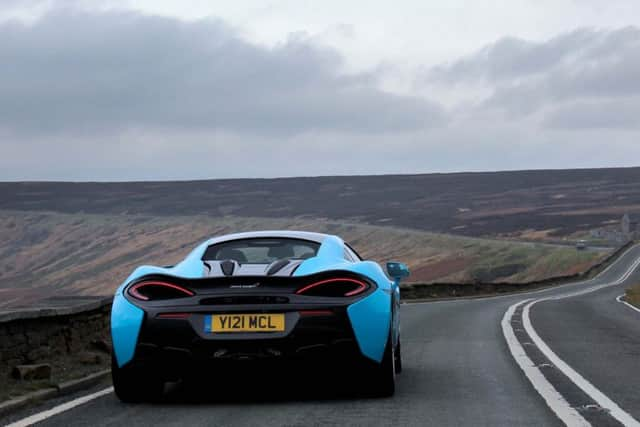Making a name in motoring design


Just the sensation of names like Ferrari, Maserati or Lamborghini tripping off the tongue conjures a sense of romance that immediately puts the Italians in pole position.
Could the same really be said of Sheffield, Huddersfield or Rotherham? Actually yes, the Yorkshire talent underpinning the success of established British supercar brands like McLaren and Aston Martin seemingly capable of beating the Italians at their own game. It doesn’t stop there either, Leeds-based entrepreneur Lawrence Tomlinson recently confirmed he’ll be selling road-going versions of his Ginetta racing cars for nearly half a million pounds apiece, their hi-tech engineering a product of his Garforth-based production facility.
Advertisement
Hide AdAdvertisement
Hide AdFoundations for this success go beyond the region’s traditions as an industrial powerhouse too. While McLaren has just opened a new manufacturing facility in South Yorkshire, the designer behind the stunning lines of its latest cars is Leeds born and bred and proud to express his Yorkshire values through the stunning vehicles he creates.


His opposite number at Aston Martin, meanwhile, is the son of a Sheffield blacksmith, trained at Teesside University and says his design work carries with it the combined influence of the region’s proud engineering heritage and awe-inspiring natural scenery.
So how has a Yorkshire upbringing and education equipped them to design cars costing upwards of a million pounds apiece and considered the very pinnacle of style, luxury and technology? He may now be based at the firm’s headquarters, in Woking, but McLaren design director Rob Melville grew up in Rawdon, studied at Jacob Kramer College (now Leeds Arts University) and the University of Huddersfield and considers the region’s countryside and plain-speaking culture as inspiration for his work.
In visual terms Melville’s job is to convey the legacy of McLaren’s sporting success and reputation as a technological innovator, all the while incorporating the practical demands of F1-inspired aerodynamics, safety regulations and a thousand and one other considerations. This would be hard enough on its own but he also has to make it look as awe-inspiring in city traffic as it does powering around a race track.
Advertisement
Hide AdAdvertisement
Hide Ad“My dad was an engineer and my mum was an artist,” he says, “so that combination got me into design. And our mission statement at McLaren is to make plain-speaking, breath-taking products that tell the story about their function. You look at it and understand how it works – it’s not based on fashion, it’s based on making what you need and making it look beautiful.”
He describes how an F1 car has a ‘biomechanical’ appearance combining extremes of man-made technology with influences from the natural world. And he says Leeds was the perfect environment for an appreciation of these seemingly contrasting influences. “I think growing up somewhere on the edge of the city and the edge of the countryside is why I fit with McLaren,” he reflects.
“My dad was obsessed with all forms of motorsport so there was that influence. But there are pictures of me as a child out on walks in the woods and I was always examining things to see how they were put together. If you look at an F1 car you’ll see shapes from nature because they work and it’s that combination that helps me design cars.”
Yorkshire folk take pride in telling it straight, so has this instinct given Rob a competitive advantage in his field? “I think there’s probably something in that,” he laughs. “All the way through training you’re taught to communicate your ideas and I think it’s important to explain them in plain and simple fashion. You have to be a salesman, in a way.”
Advertisement
Hide AdAdvertisement
Hide AdMarek Reichman, his opposite number at Aston Martin, brings a similar sense of plain-speaking artistry to his job. Like Rob he was raised, educated and trained here in the north and also took that experience with him to the Royal College of Art in London. Both were sponsored through their masters by Jaguar Land Rover and started their careers there, underlining the importance of partnerships between British industry and educational institutions in helping homegrown talent reach the very top.
“I grew up literally within shouting distance of Orgreave – we could hear the miners and the police battling from our house,” he recalls. “One of the reasons I wanted to be an inventor of stuff and a maker of stuff was the fact I grew up in Sheffield. It is of course a very industrial town and I love that grittiness but it’s surrounded by hills and when you go up there you’re surrounded by countryside as beautiful as anywhere in the world.”
Again it’s this juxtaposition of post-industrial urban landscapes and the epic scale of the natural ones that has inspired Reichman’s work, one of his mottos being to “find the beauty”. In practical terms this meant splitting his student years in Middlesbrough between his work and exploring the North York Moors and neighbouring coastline.
And at the RCA he found his background was something to celebrate, not play down. “When I was working with peers in architecture, silversmithing or graphic design the melting pot of ideas and sense of inclusivity was a real eye-opener,” he says. “Suddenly you’re not embarrassed to be from the North, you’re not embarrassed to talk about steel or being a blacksmith’s son – all of these things mean something and people have a curiosity about how it might inform or inspire their own way of thinking.”
Advertisement
Hide AdAdvertisement
Hide AdIn some ways it might seem strange that the down-to-earth sensibilities of Melville and Reichman have found expression in extravagant cars for wealthy customers. The vehicles they create speak of luxury and technology and yet the four-wheeled expression of plain-speaking Yorkshire pragmatism clearly strikes a chord. Nobody needs an explanation of what these cars are about, they tell you in no uncertain terms.
It’s also satisfying to learn that the very site of the Orgreave coking plant – for years a powerful symbol of the north’s industrial decline – now represents the area’s rebirth as a home of hi-tech manufacturing. Though it will never employ people in the tens of thousands like steel or mining.
But the fact McLaren chose South Yorkshire as the site for its new £50m carbon fibre production facility speaks volumes of the region’s reborn self-confidence and ability to provide both the foundations and inspiration for luxury products exporting British artistry and industry to the world.
Making a name in motoring design
Arizona is a long way from Yorkshire, but the new car McLaren recently presented to the world’s motoring press in the wide open desert outside Phoenix is a prime example of Rob Melville’s design ethos in action.
Advertisement
Hide AdAdvertisement
Hide AdOn the face of it this £250,000, 720 horsepower, 200mph-plus supercar is science fiction fantasy compared with everything else on the road.
For all that, and while its race team is a household name in F1, McLaren is new to the road car game and needs to shout louder to make its presence felt against established names like Ferrari and Lamborghini.
Melville’s skill has been to communicate how the car’s incredibly complex engineering works through its styling.